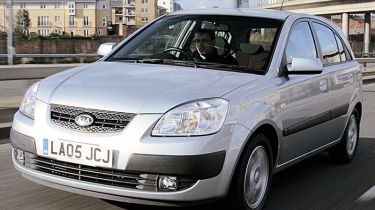Kia Rio review (2005-2011)
The original Kia Rio marked a step change in Kia's car building enterprise

Driving:
The Kia is a decent performer in town, with the comfortable ride dealing with bumps adequately, but it's less impressive on a back road. Vague steering, body roll and a rubbery gearshift spoil driving enjoyment. The diesel is the most impressive engine, proving refined around town and extremely responsive. Mid-range acceleration is genuinely quite rapid, making it worth the extra cost over the 1.4-litre petrol unit - though this unit is also good.
Marketplace:
The nose of the Rio has a hint of Ford Fiesta about it, as well as resemblance to the rest of the Kia range, but the overall appearance is a little plain. The rear is better, and more distinctive because of the clear lamps. The supermini-sized five-door hatchback has a choice of either a 1.4-litre petrol engine, or a 1.5-litre turbodiesel. Two trim levels provide a simple, straightforward model line-up; you can choose between GS and LX models. Obvious rivals include the Mitsubishi Colt, Honda Jazz, Nissan Micra, Hyundai Getz and Skoda Fabia.
Owning:
The cabin, in line with all of Kia's recent models, is clutter-free. Metal effect plastic looks smart on the centre console (though it's only fitted to posher LX models), and controls for the air conditioning are straightforward. There are some hard plastics, but this is a minor gripe, and for the most part the cabin quality is fine -the Kia even has damped grab handles. One downside is that the radio is still an aftermarket unit - the firm really needs to improve on this. The cabin is also practical, with plenty of cubby space and good cup holders. And there's lots of room too, while the Rio has a big boot. Seats up, it's fine for the weekly shop, and the rear bench splits and folds, if somewhat awkwardly. Rear legroom is fine with the chairs up, and four average-sized adults can sit in reasonable comfort for a long journey. The Rio is also economical, particularly the diesel, and servicing should be inexpensive (albeit every 10,000 miles). The unlimited-mileage warranty is good but retained values may still be a small stumbling block.



